Comprehensive Report: Subway's Supply Chain Management Strategies
VerifiedAdded on 2021/06/18
|12
|2927
|58
Report
AI Summary
This report provides a comprehensive analysis of Subway's supply chain management, focusing on its operational strategies, procurement processes, and sustainability initiatives. It examines the structure of Subway's supply chain, including its suppliers, distributors, and franchisees, and how these elements contribute to its global operations. The report discusses the company's approach to procurement, highlighting the use of global purchasing and technology to ensure efficiency and freshness in its products. Furthermore, it explores Subway's efforts in supply chain sustainability, including food safety, local sourcing, and environmental considerations. The report also addresses the challenges Subway faces, such as declining sales and the need for product upgrades, and offers recommendations for improving its supply chain practices to maintain its competitive edge in the fast-food industry. The analysis covers the European Independent Purchasing Company (EIPC) and how they manage the supply chain. The report concludes by assessing the impact of the company's supply chain management on its overall business performance.
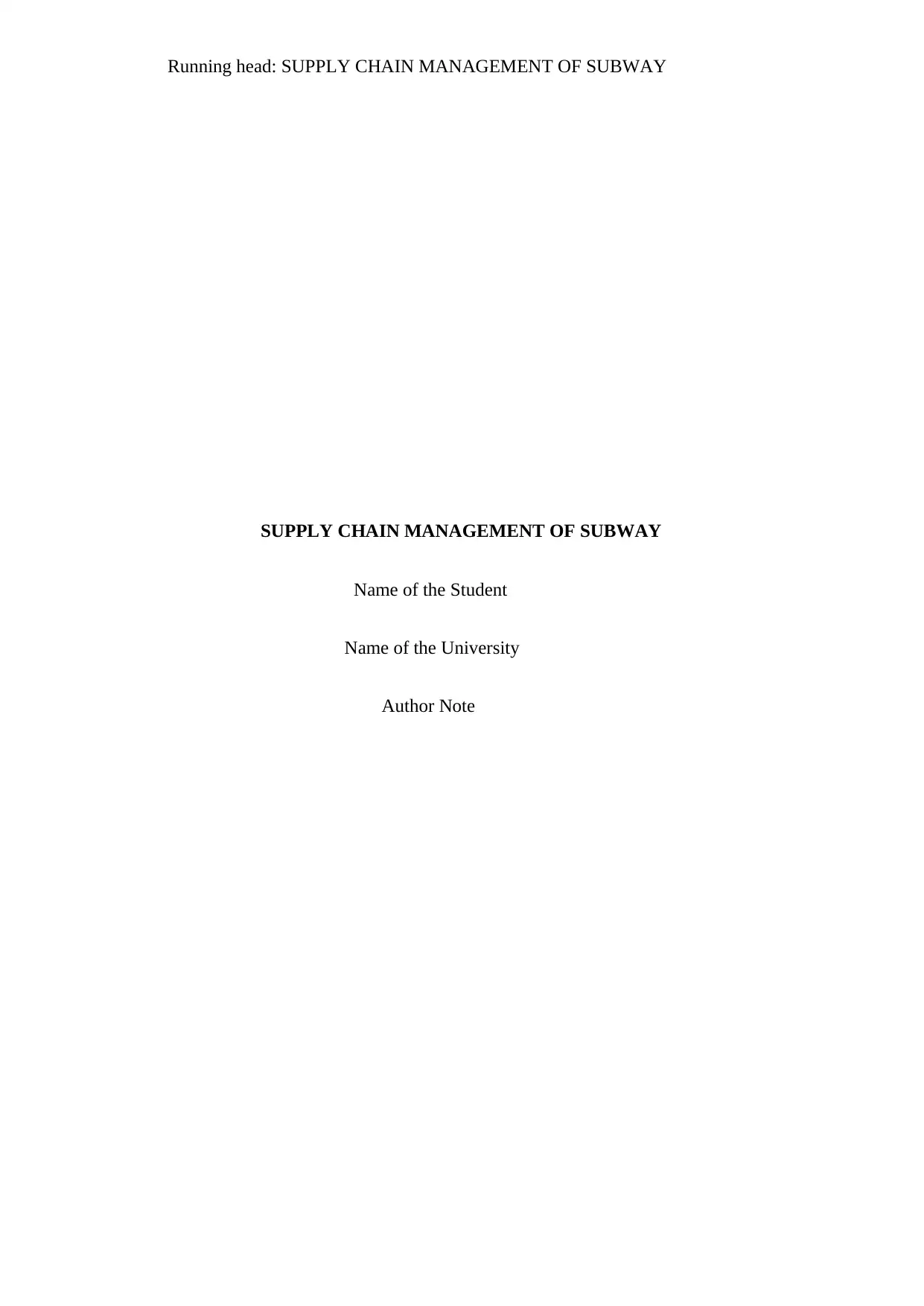
Running head: SUPPLY CHAIN MANAGEMENT OF SUBWAY
SUPPLY CHAIN MANAGEMENT OF SUBWAY
Name of the Student
Name of the University
Author Note
SUPPLY CHAIN MANAGEMENT OF SUBWAY
Name of the Student
Name of the University
Author Note
Paraphrase This Document
Need a fresh take? Get an instant paraphrase of this document with our AI Paraphraser
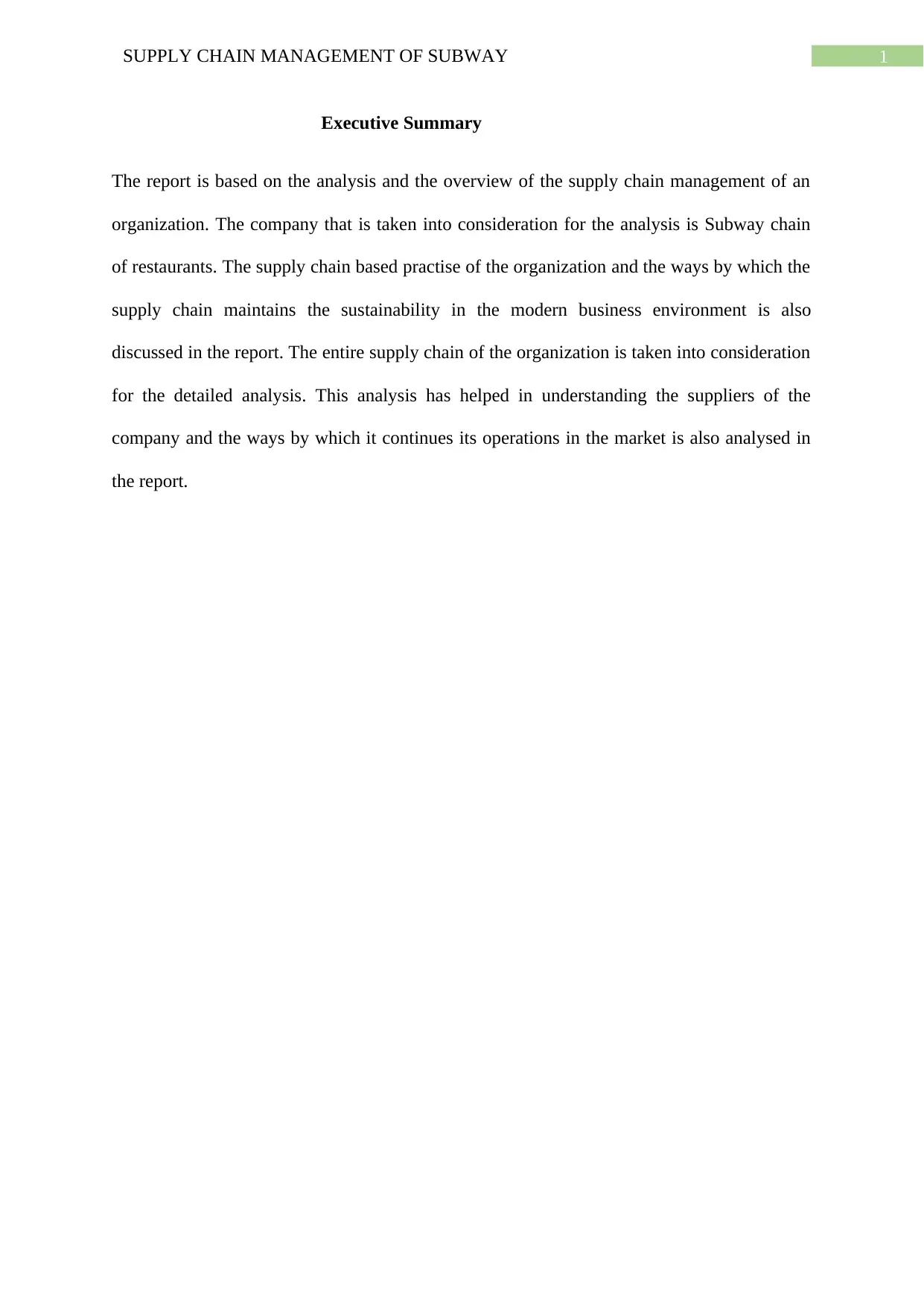
1SUPPLY CHAIN MANAGEMENT OF SUBWAY
Executive Summary
The report is based on the analysis and the overview of the supply chain management of an
organization. The company that is taken into consideration for the analysis is Subway chain
of restaurants. The supply chain based practise of the organization and the ways by which the
supply chain maintains the sustainability in the modern business environment is also
discussed in the report. The entire supply chain of the organization is taken into consideration
for the detailed analysis. This analysis has helped in understanding the suppliers of the
company and the ways by which it continues its operations in the market is also analysed in
the report.
Executive Summary
The report is based on the analysis and the overview of the supply chain management of an
organization. The company that is taken into consideration for the analysis is Subway chain
of restaurants. The supply chain based practise of the organization and the ways by which the
supply chain maintains the sustainability in the modern business environment is also
discussed in the report. The entire supply chain of the organization is taken into consideration
for the detailed analysis. This analysis has helped in understanding the suppliers of the
company and the ways by which it continues its operations in the market is also analysed in
the report.
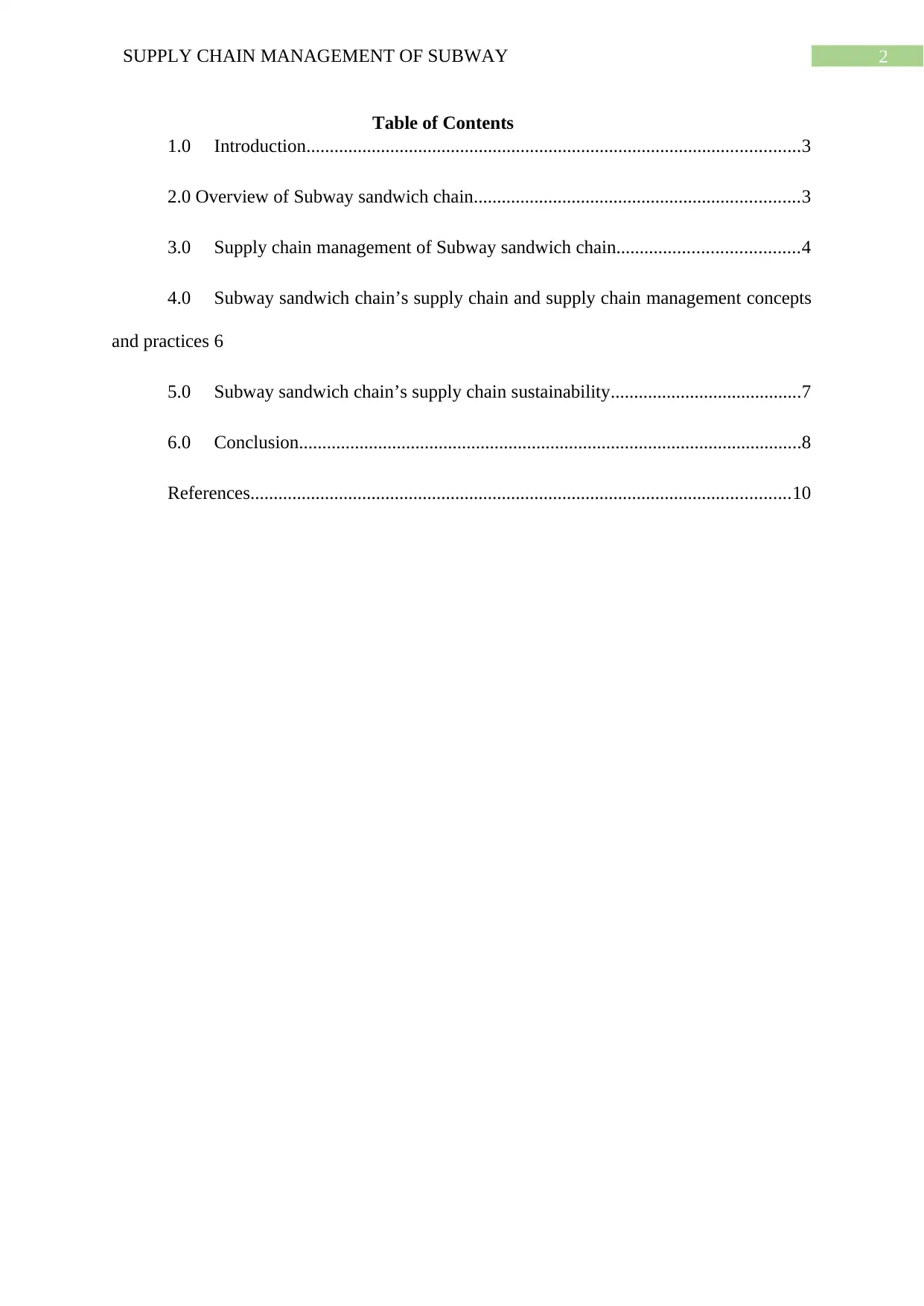
2SUPPLY CHAIN MANAGEMENT OF SUBWAY
Table of Contents
1.0 Introduction..........................................................................................................3
2.0 Overview of Subway sandwich chain......................................................................3
3.0 Supply chain management of Subway sandwich chain.......................................4
4.0 Subway sandwich chain’s supply chain and supply chain management concepts
and practices 6
5.0 Subway sandwich chain’s supply chain sustainability.........................................7
6.0 Conclusion............................................................................................................8
References....................................................................................................................10
Table of Contents
1.0 Introduction..........................................................................................................3
2.0 Overview of Subway sandwich chain......................................................................3
3.0 Supply chain management of Subway sandwich chain.......................................4
4.0 Subway sandwich chain’s supply chain and supply chain management concepts
and practices 6
5.0 Subway sandwich chain’s supply chain sustainability.........................................7
6.0 Conclusion............................................................................................................8
References....................................................................................................................10
⊘ This is a preview!⊘
Do you want full access?
Subscribe today to unlock all pages.

Trusted by 1+ million students worldwide
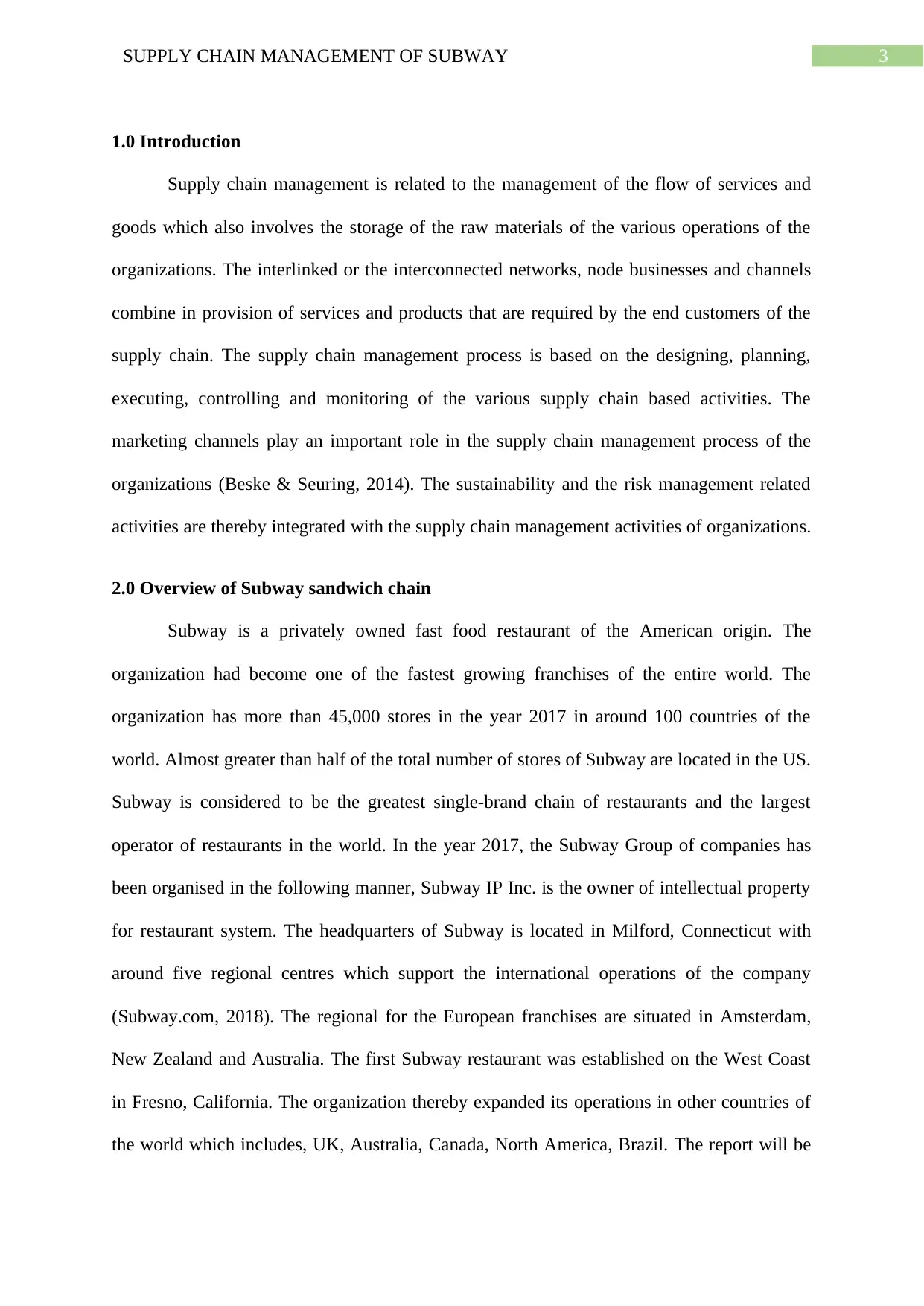
3SUPPLY CHAIN MANAGEMENT OF SUBWAY
1.0 Introduction
Supply chain management is related to the management of the flow of services and
goods which also involves the storage of the raw materials of the various operations of the
organizations. The interlinked or the interconnected networks, node businesses and channels
combine in provision of services and products that are required by the end customers of the
supply chain. The supply chain management process is based on the designing, planning,
executing, controlling and monitoring of the various supply chain based activities. The
marketing channels play an important role in the supply chain management process of the
organizations (Beske & Seuring, 2014). The sustainability and the risk management related
activities are thereby integrated with the supply chain management activities of organizations.
2.0 Overview of Subway sandwich chain
Subway is a privately owned fast food restaurant of the American origin. The
organization had become one of the fastest growing franchises of the entire world. The
organization has more than 45,000 stores in the year 2017 in around 100 countries of the
world. Almost greater than half of the total number of stores of Subway are located in the US.
Subway is considered to be the greatest single-brand chain of restaurants and the largest
operator of restaurants in the world. In the year 2017, the Subway Group of companies has
been organised in the following manner, Subway IP Inc. is the owner of intellectual property
for restaurant system. The headquarters of Subway is located in Milford, Connecticut with
around five regional centres which support the international operations of the company
(Subway.com, 2018). The regional for the European franchises are situated in Amsterdam,
New Zealand and Australia. The first Subway restaurant was established on the West Coast
in Fresno, California. The organization thereby expanded its operations in other countries of
the world which includes, UK, Australia, Canada, North America, Brazil. The report will be
1.0 Introduction
Supply chain management is related to the management of the flow of services and
goods which also involves the storage of the raw materials of the various operations of the
organizations. The interlinked or the interconnected networks, node businesses and channels
combine in provision of services and products that are required by the end customers of the
supply chain. The supply chain management process is based on the designing, planning,
executing, controlling and monitoring of the various supply chain based activities. The
marketing channels play an important role in the supply chain management process of the
organizations (Beske & Seuring, 2014). The sustainability and the risk management related
activities are thereby integrated with the supply chain management activities of organizations.
2.0 Overview of Subway sandwich chain
Subway is a privately owned fast food restaurant of the American origin. The
organization had become one of the fastest growing franchises of the entire world. The
organization has more than 45,000 stores in the year 2017 in around 100 countries of the
world. Almost greater than half of the total number of stores of Subway are located in the US.
Subway is considered to be the greatest single-brand chain of restaurants and the largest
operator of restaurants in the world. In the year 2017, the Subway Group of companies has
been organised in the following manner, Subway IP Inc. is the owner of intellectual property
for restaurant system. The headquarters of Subway is located in Milford, Connecticut with
around five regional centres which support the international operations of the company
(Subway.com, 2018). The regional for the European franchises are situated in Amsterdam,
New Zealand and Australia. The first Subway restaurant was established on the West Coast
in Fresno, California. The organization thereby expanded its operations in other countries of
the world which includes, UK, Australia, Canada, North America, Brazil. The report will be
Paraphrase This Document
Need a fresh take? Get an instant paraphrase of this document with our AI Paraphraser
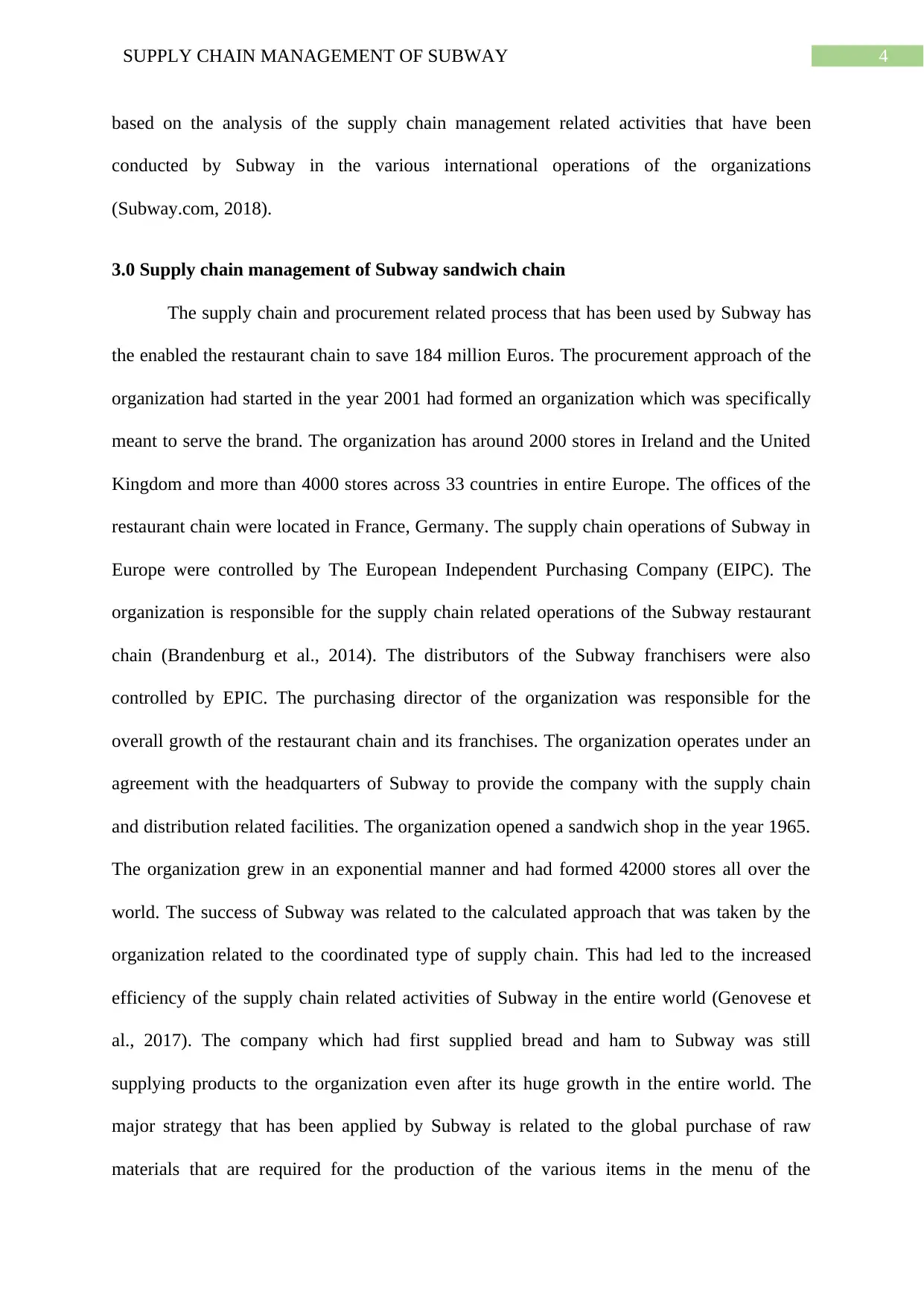
4SUPPLY CHAIN MANAGEMENT OF SUBWAY
based on the analysis of the supply chain management related activities that have been
conducted by Subway in the various international operations of the organizations
(Subway.com, 2018).
3.0 Supply chain management of Subway sandwich chain
The supply chain and procurement related process that has been used by Subway has
the enabled the restaurant chain to save 184 million Euros. The procurement approach of the
organization had started in the year 2001 had formed an organization which was specifically
meant to serve the brand. The organization has around 2000 stores in Ireland and the United
Kingdom and more than 4000 stores across 33 countries in entire Europe. The offices of the
restaurant chain were located in France, Germany. The supply chain operations of Subway in
Europe were controlled by The European Independent Purchasing Company (EIPC). The
organization is responsible for the supply chain related operations of the Subway restaurant
chain (Brandenburg et al., 2014). The distributors of the Subway franchisers were also
controlled by EPIC. The purchasing director of the organization was responsible for the
overall growth of the restaurant chain and its franchises. The organization operates under an
agreement with the headquarters of Subway to provide the company with the supply chain
and distribution related facilities. The organization opened a sandwich shop in the year 1965.
The organization grew in an exponential manner and had formed 42000 stores all over the
world. The success of Subway was related to the calculated approach that was taken by the
organization related to the coordinated type of supply chain. This had led to the increased
efficiency of the supply chain related activities of Subway in the entire world (Genovese et
al., 2017). The company which had first supplied bread and ham to Subway was still
supplying products to the organization even after its huge growth in the entire world. The
major strategy that has been applied by Subway is related to the global purchase of raw
materials that are required for the production of the various items in the menu of the
based on the analysis of the supply chain management related activities that have been
conducted by Subway in the various international operations of the organizations
(Subway.com, 2018).
3.0 Supply chain management of Subway sandwich chain
The supply chain and procurement related process that has been used by Subway has
the enabled the restaurant chain to save 184 million Euros. The procurement approach of the
organization had started in the year 2001 had formed an organization which was specifically
meant to serve the brand. The organization has around 2000 stores in Ireland and the United
Kingdom and more than 4000 stores across 33 countries in entire Europe. The offices of the
restaurant chain were located in France, Germany. The supply chain operations of Subway in
Europe were controlled by The European Independent Purchasing Company (EIPC). The
organization is responsible for the supply chain related operations of the Subway restaurant
chain (Brandenburg et al., 2014). The distributors of the Subway franchisers were also
controlled by EPIC. The purchasing director of the organization was responsible for the
overall growth of the restaurant chain and its franchises. The organization operates under an
agreement with the headquarters of Subway to provide the company with the supply chain
and distribution related facilities. The organization opened a sandwich shop in the year 1965.
The organization grew in an exponential manner and had formed 42000 stores all over the
world. The success of Subway was related to the calculated approach that was taken by the
organization related to the coordinated type of supply chain. This had led to the increased
efficiency of the supply chain related activities of Subway in the entire world (Genovese et
al., 2017). The company which had first supplied bread and ham to Subway was still
supplying products to the organization even after its huge growth in the entire world. The
major strategy that has been applied by Subway is related to the global purchase of raw
materials that are required for the production of the various items in the menu of the
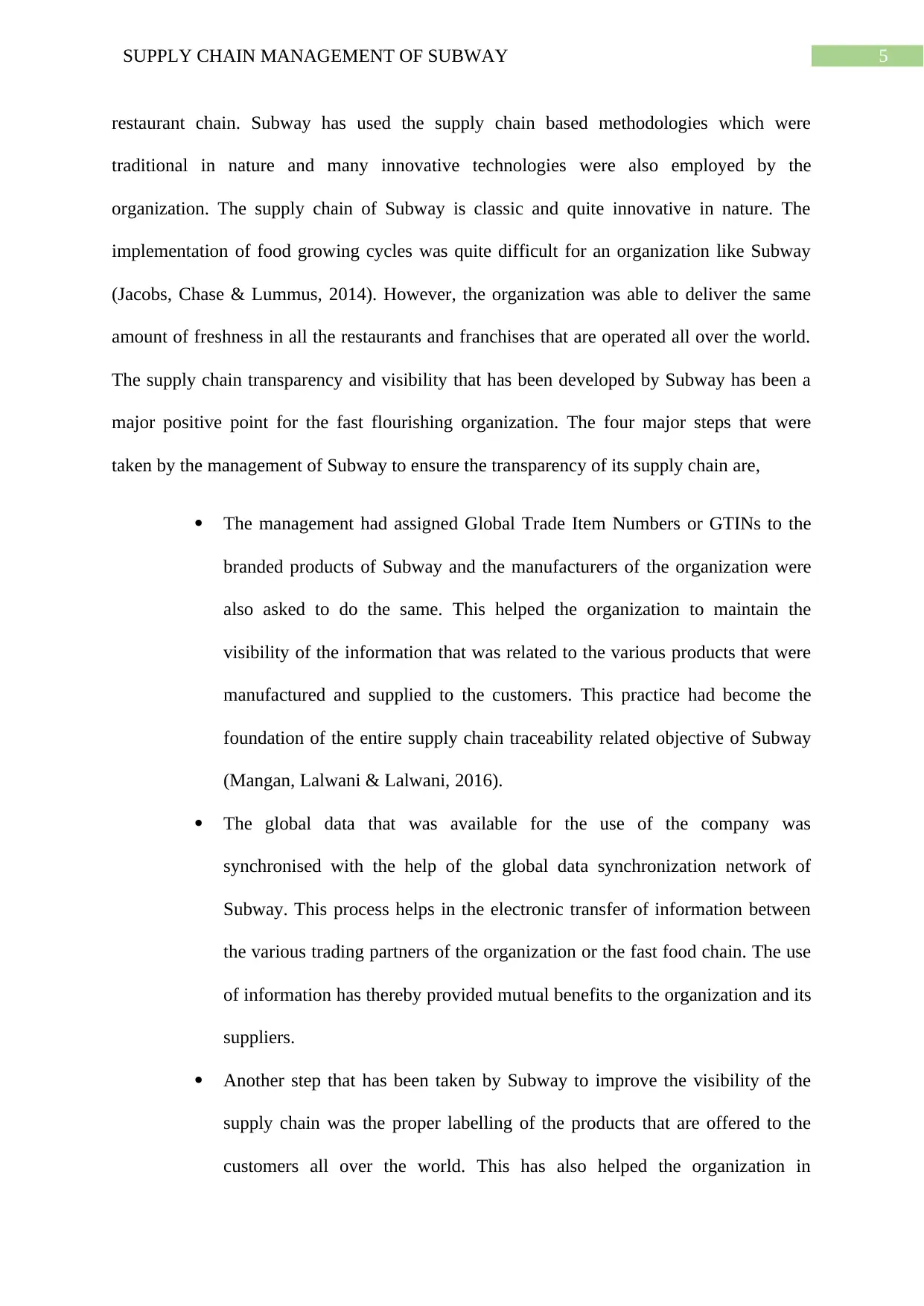
5SUPPLY CHAIN MANAGEMENT OF SUBWAY
restaurant chain. Subway has used the supply chain based methodologies which were
traditional in nature and many innovative technologies were also employed by the
organization. The supply chain of Subway is classic and quite innovative in nature. The
implementation of food growing cycles was quite difficult for an organization like Subway
(Jacobs, Chase & Lummus, 2014). However, the organization was able to deliver the same
amount of freshness in all the restaurants and franchises that are operated all over the world.
The supply chain transparency and visibility that has been developed by Subway has been a
major positive point for the fast flourishing organization. The four major steps that were
taken by the management of Subway to ensure the transparency of its supply chain are,
The management had assigned Global Trade Item Numbers or GTINs to the
branded products of Subway and the manufacturers of the organization were
also asked to do the same. This helped the organization to maintain the
visibility of the information that was related to the various products that were
manufactured and supplied to the customers. This practice had become the
foundation of the entire supply chain traceability related objective of Subway
(Mangan, Lalwani & Lalwani, 2016).
The global data that was available for the use of the company was
synchronised with the help of the global data synchronization network of
Subway. This process helps in the electronic transfer of information between
the various trading partners of the organization or the fast food chain. The use
of information has thereby provided mutual benefits to the organization and its
suppliers.
Another step that has been taken by Subway to improve the visibility of the
supply chain was the proper labelling of the products that are offered to the
customers all over the world. This has also helped the organization in
restaurant chain. Subway has used the supply chain based methodologies which were
traditional in nature and many innovative technologies were also employed by the
organization. The supply chain of Subway is classic and quite innovative in nature. The
implementation of food growing cycles was quite difficult for an organization like Subway
(Jacobs, Chase & Lummus, 2014). However, the organization was able to deliver the same
amount of freshness in all the restaurants and franchises that are operated all over the world.
The supply chain transparency and visibility that has been developed by Subway has been a
major positive point for the fast flourishing organization. The four major steps that were
taken by the management of Subway to ensure the transparency of its supply chain are,
The management had assigned Global Trade Item Numbers or GTINs to the
branded products of Subway and the manufacturers of the organization were
also asked to do the same. This helped the organization to maintain the
visibility of the information that was related to the various products that were
manufactured and supplied to the customers. This practice had become the
foundation of the entire supply chain traceability related objective of Subway
(Mangan, Lalwani & Lalwani, 2016).
The global data that was available for the use of the company was
synchronised with the help of the global data synchronization network of
Subway. This process helps in the electronic transfer of information between
the various trading partners of the organization or the fast food chain. The use
of information has thereby provided mutual benefits to the organization and its
suppliers.
Another step that has been taken by Subway to improve the visibility of the
supply chain was the proper labelling of the products that are offered to the
customers all over the world. This has also helped the organization in
⊘ This is a preview!⊘
Do you want full access?
Subscribe today to unlock all pages.

Trusted by 1+ million students worldwide
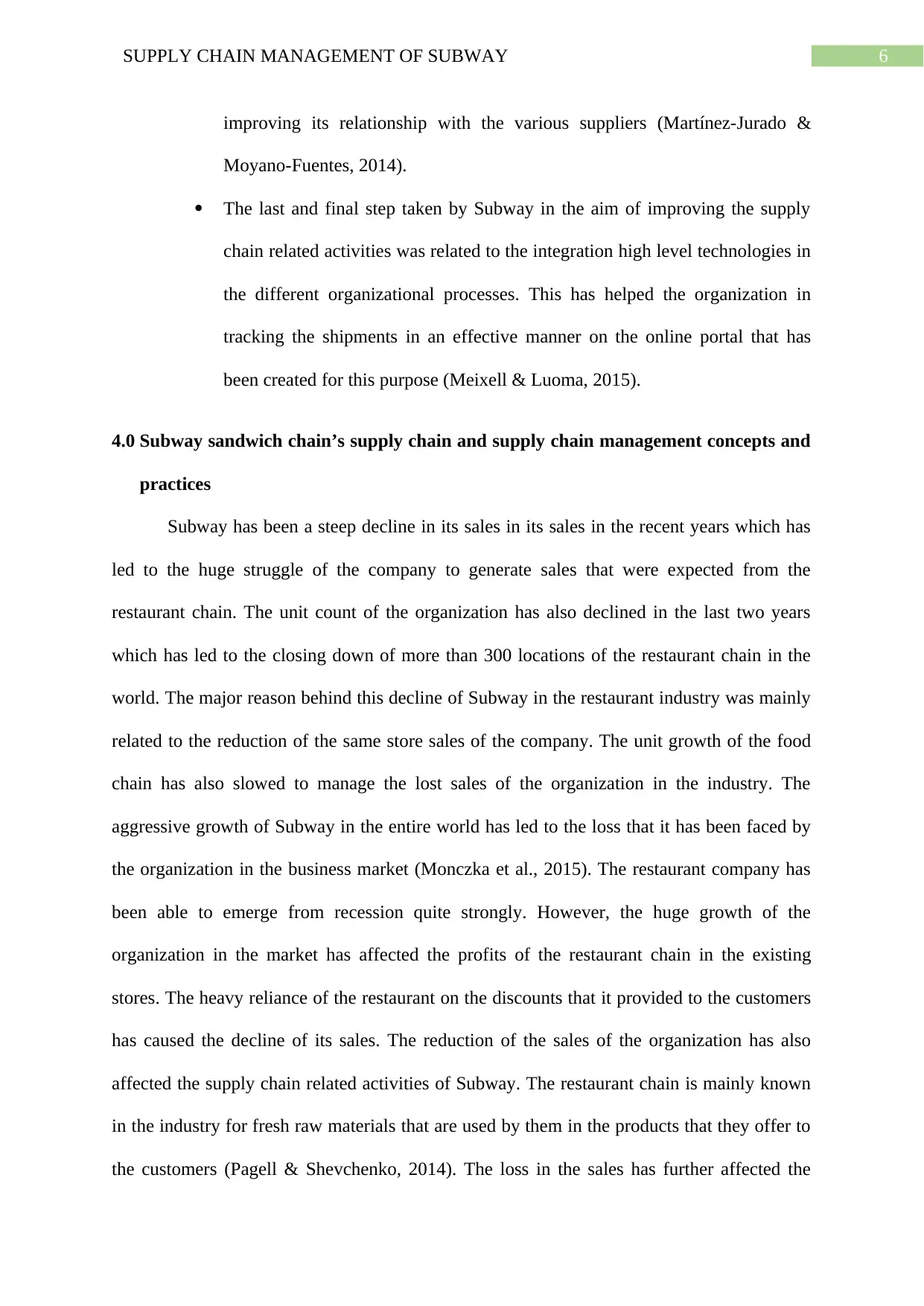
6SUPPLY CHAIN MANAGEMENT OF SUBWAY
improving its relationship with the various suppliers (Martínez-Jurado &
Moyano-Fuentes, 2014).
The last and final step taken by Subway in the aim of improving the supply
chain related activities was related to the integration high level technologies in
the different organizational processes. This has helped the organization in
tracking the shipments in an effective manner on the online portal that has
been created for this purpose (Meixell & Luoma, 2015).
4.0 Subway sandwich chain’s supply chain and supply chain management concepts and
practices
Subway has been a steep decline in its sales in its sales in the recent years which has
led to the huge struggle of the company to generate sales that were expected from the
restaurant chain. The unit count of the organization has also declined in the last two years
which has led to the closing down of more than 300 locations of the restaurant chain in the
world. The major reason behind this decline of Subway in the restaurant industry was mainly
related to the reduction of the same store sales of the company. The unit growth of the food
chain has also slowed to manage the lost sales of the organization in the industry. The
aggressive growth of Subway in the entire world has led to the loss that it has been faced by
the organization in the business market (Monczka et al., 2015). The restaurant company has
been able to emerge from recession quite strongly. However, the huge growth of the
organization in the market has affected the profits of the restaurant chain in the existing
stores. The heavy reliance of the restaurant on the discounts that it provided to the customers
has caused the decline of its sales. The reduction of the sales of the organization has also
affected the supply chain related activities of Subway. The restaurant chain is mainly known
in the industry for fresh raw materials that are used by them in the products that they offer to
the customers (Pagell & Shevchenko, 2014). The loss in the sales has further affected the
improving its relationship with the various suppliers (Martínez-Jurado &
Moyano-Fuentes, 2014).
The last and final step taken by Subway in the aim of improving the supply
chain related activities was related to the integration high level technologies in
the different organizational processes. This has helped the organization in
tracking the shipments in an effective manner on the online portal that has
been created for this purpose (Meixell & Luoma, 2015).
4.0 Subway sandwich chain’s supply chain and supply chain management concepts and
practices
Subway has been a steep decline in its sales in its sales in the recent years which has
led to the huge struggle of the company to generate sales that were expected from the
restaurant chain. The unit count of the organization has also declined in the last two years
which has led to the closing down of more than 300 locations of the restaurant chain in the
world. The major reason behind this decline of Subway in the restaurant industry was mainly
related to the reduction of the same store sales of the company. The unit growth of the food
chain has also slowed to manage the lost sales of the organization in the industry. The
aggressive growth of Subway in the entire world has led to the loss that it has been faced by
the organization in the business market (Monczka et al., 2015). The restaurant company has
been able to emerge from recession quite strongly. However, the huge growth of the
organization in the market has affected the profits of the restaurant chain in the existing
stores. The heavy reliance of the restaurant on the discounts that it provided to the customers
has caused the decline of its sales. The reduction of the sales of the organization has also
affected the supply chain related activities of Subway. The restaurant chain is mainly known
in the industry for fresh raw materials that are used by them in the products that they offer to
the customers (Pagell & Shevchenko, 2014). The loss in the sales has further affected the
Paraphrase This Document
Need a fresh take? Get an instant paraphrase of this document with our AI Paraphraser
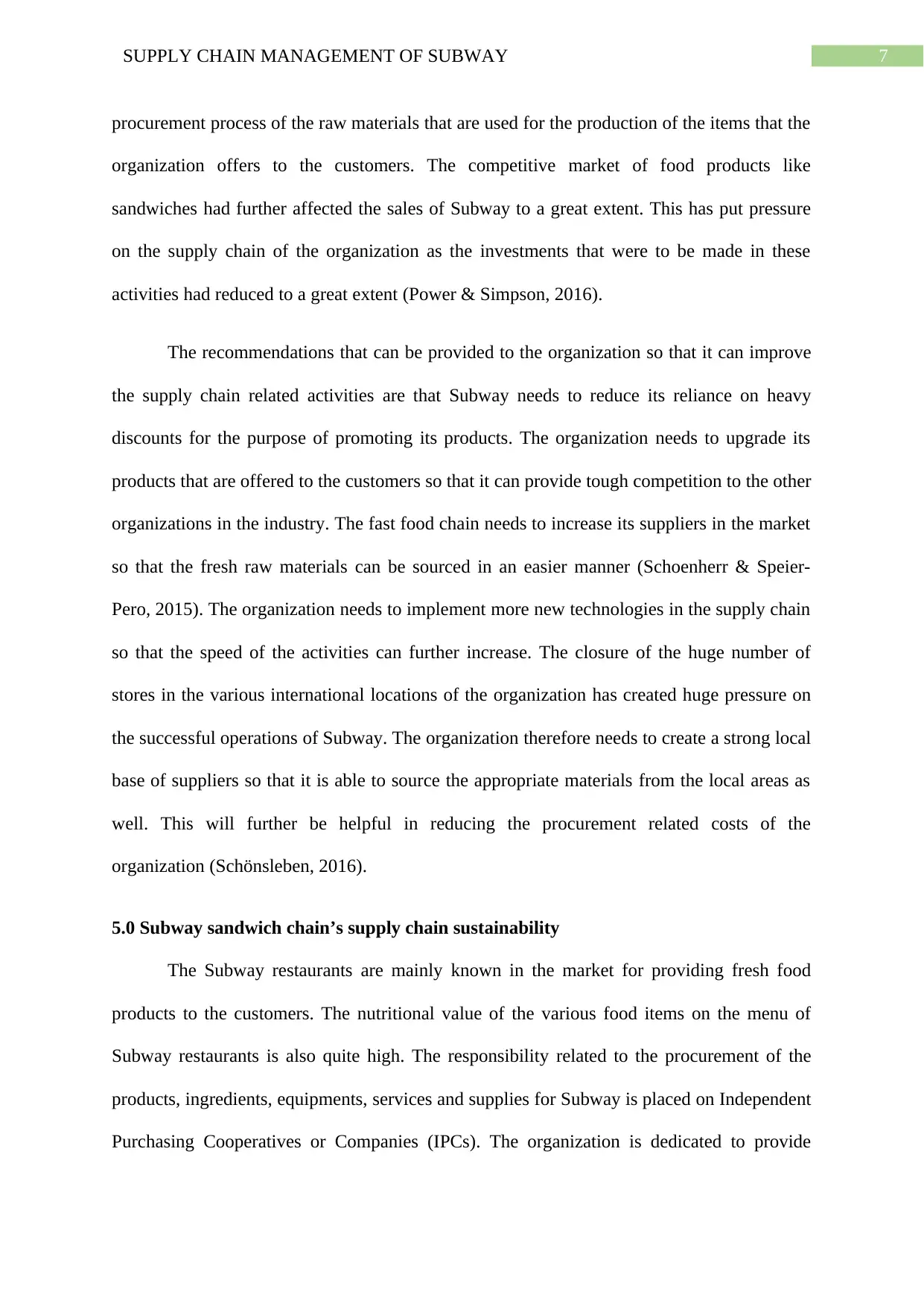
7SUPPLY CHAIN MANAGEMENT OF SUBWAY
procurement process of the raw materials that are used for the production of the items that the
organization offers to the customers. The competitive market of food products like
sandwiches had further affected the sales of Subway to a great extent. This has put pressure
on the supply chain of the organization as the investments that were to be made in these
activities had reduced to a great extent (Power & Simpson, 2016).
The recommendations that can be provided to the organization so that it can improve
the supply chain related activities are that Subway needs to reduce its reliance on heavy
discounts for the purpose of promoting its products. The organization needs to upgrade its
products that are offered to the customers so that it can provide tough competition to the other
organizations in the industry. The fast food chain needs to increase its suppliers in the market
so that the fresh raw materials can be sourced in an easier manner (Schoenherr & Speier‐
Pero, 2015). The organization needs to implement more new technologies in the supply chain
so that the speed of the activities can further increase. The closure of the huge number of
stores in the various international locations of the organization has created huge pressure on
the successful operations of Subway. The organization therefore needs to create a strong local
base of suppliers so that it is able to source the appropriate materials from the local areas as
well. This will further be helpful in reducing the procurement related costs of the
organization (Schönsleben, 2016).
5.0 Subway sandwich chain’s supply chain sustainability
The Subway restaurants are mainly known in the market for providing fresh food
products to the customers. The nutritional value of the various food items on the menu of
Subway restaurants is also quite high. The responsibility related to the procurement of the
products, ingredients, equipments, services and supplies for Subway is placed on Independent
Purchasing Cooperatives or Companies (IPCs). The organization is dedicated to provide
procurement process of the raw materials that are used for the production of the items that the
organization offers to the customers. The competitive market of food products like
sandwiches had further affected the sales of Subway to a great extent. This has put pressure
on the supply chain of the organization as the investments that were to be made in these
activities had reduced to a great extent (Power & Simpson, 2016).
The recommendations that can be provided to the organization so that it can improve
the supply chain related activities are that Subway needs to reduce its reliance on heavy
discounts for the purpose of promoting its products. The organization needs to upgrade its
products that are offered to the customers so that it can provide tough competition to the other
organizations in the industry. The fast food chain needs to increase its suppliers in the market
so that the fresh raw materials can be sourced in an easier manner (Schoenherr & Speier‐
Pero, 2015). The organization needs to implement more new technologies in the supply chain
so that the speed of the activities can further increase. The closure of the huge number of
stores in the various international locations of the organization has created huge pressure on
the successful operations of Subway. The organization therefore needs to create a strong local
base of suppliers so that it is able to source the appropriate materials from the local areas as
well. This will further be helpful in reducing the procurement related costs of the
organization (Schönsleben, 2016).
5.0 Subway sandwich chain’s supply chain sustainability
The Subway restaurants are mainly known in the market for providing fresh food
products to the customers. The nutritional value of the various food items on the menu of
Subway restaurants is also quite high. The responsibility related to the procurement of the
products, ingredients, equipments, services and supplies for Subway is placed on Independent
Purchasing Cooperatives or Companies (IPCs). The organization is dedicated to provide
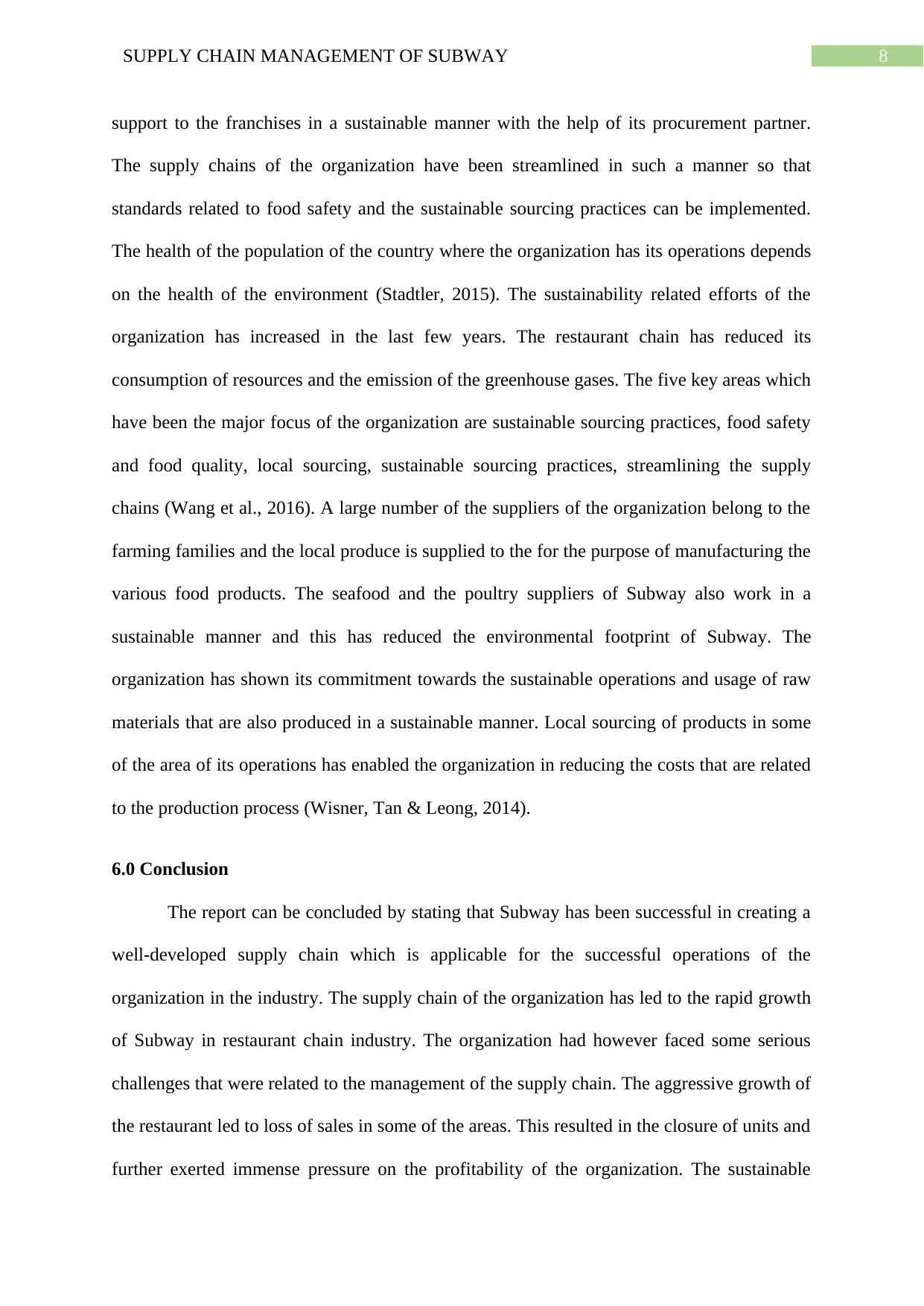
8SUPPLY CHAIN MANAGEMENT OF SUBWAY
support to the franchises in a sustainable manner with the help of its procurement partner.
The supply chains of the organization have been streamlined in such a manner so that
standards related to food safety and the sustainable sourcing practices can be implemented.
The health of the population of the country where the organization has its operations depends
on the health of the environment (Stadtler, 2015). The sustainability related efforts of the
organization has increased in the last few years. The restaurant chain has reduced its
consumption of resources and the emission of the greenhouse gases. The five key areas which
have been the major focus of the organization are sustainable sourcing practices, food safety
and food quality, local sourcing, sustainable sourcing practices, streamlining the supply
chains (Wang et al., 2016). A large number of the suppliers of the organization belong to the
farming families and the local produce is supplied to the for the purpose of manufacturing the
various food products. The seafood and the poultry suppliers of Subway also work in a
sustainable manner and this has reduced the environmental footprint of Subway. The
organization has shown its commitment towards the sustainable operations and usage of raw
materials that are also produced in a sustainable manner. Local sourcing of products in some
of the area of its operations has enabled the organization in reducing the costs that are related
to the production process (Wisner, Tan & Leong, 2014).
6.0 Conclusion
The report can be concluded by stating that Subway has been successful in creating a
well-developed supply chain which is applicable for the successful operations of the
organization in the industry. The supply chain of the organization has led to the rapid growth
of Subway in restaurant chain industry. The organization had however faced some serious
challenges that were related to the management of the supply chain. The aggressive growth of
the restaurant led to loss of sales in some of the areas. This resulted in the closure of units and
further exerted immense pressure on the profitability of the organization. The sustainable
support to the franchises in a sustainable manner with the help of its procurement partner.
The supply chains of the organization have been streamlined in such a manner so that
standards related to food safety and the sustainable sourcing practices can be implemented.
The health of the population of the country where the organization has its operations depends
on the health of the environment (Stadtler, 2015). The sustainability related efforts of the
organization has increased in the last few years. The restaurant chain has reduced its
consumption of resources and the emission of the greenhouse gases. The five key areas which
have been the major focus of the organization are sustainable sourcing practices, food safety
and food quality, local sourcing, sustainable sourcing practices, streamlining the supply
chains (Wang et al., 2016). A large number of the suppliers of the organization belong to the
farming families and the local produce is supplied to the for the purpose of manufacturing the
various food products. The seafood and the poultry suppliers of Subway also work in a
sustainable manner and this has reduced the environmental footprint of Subway. The
organization has shown its commitment towards the sustainable operations and usage of raw
materials that are also produced in a sustainable manner. Local sourcing of products in some
of the area of its operations has enabled the organization in reducing the costs that are related
to the production process (Wisner, Tan & Leong, 2014).
6.0 Conclusion
The report can be concluded by stating that Subway has been successful in creating a
well-developed supply chain which is applicable for the successful operations of the
organization in the industry. The supply chain of the organization has led to the rapid growth
of Subway in restaurant chain industry. The organization had however faced some serious
challenges that were related to the management of the supply chain. The aggressive growth of
the restaurant led to loss of sales in some of the areas. This resulted in the closure of units and
further exerted immense pressure on the profitability of the organization. The sustainable
⊘ This is a preview!⊘
Do you want full access?
Subscribe today to unlock all pages.

Trusted by 1+ million students worldwide
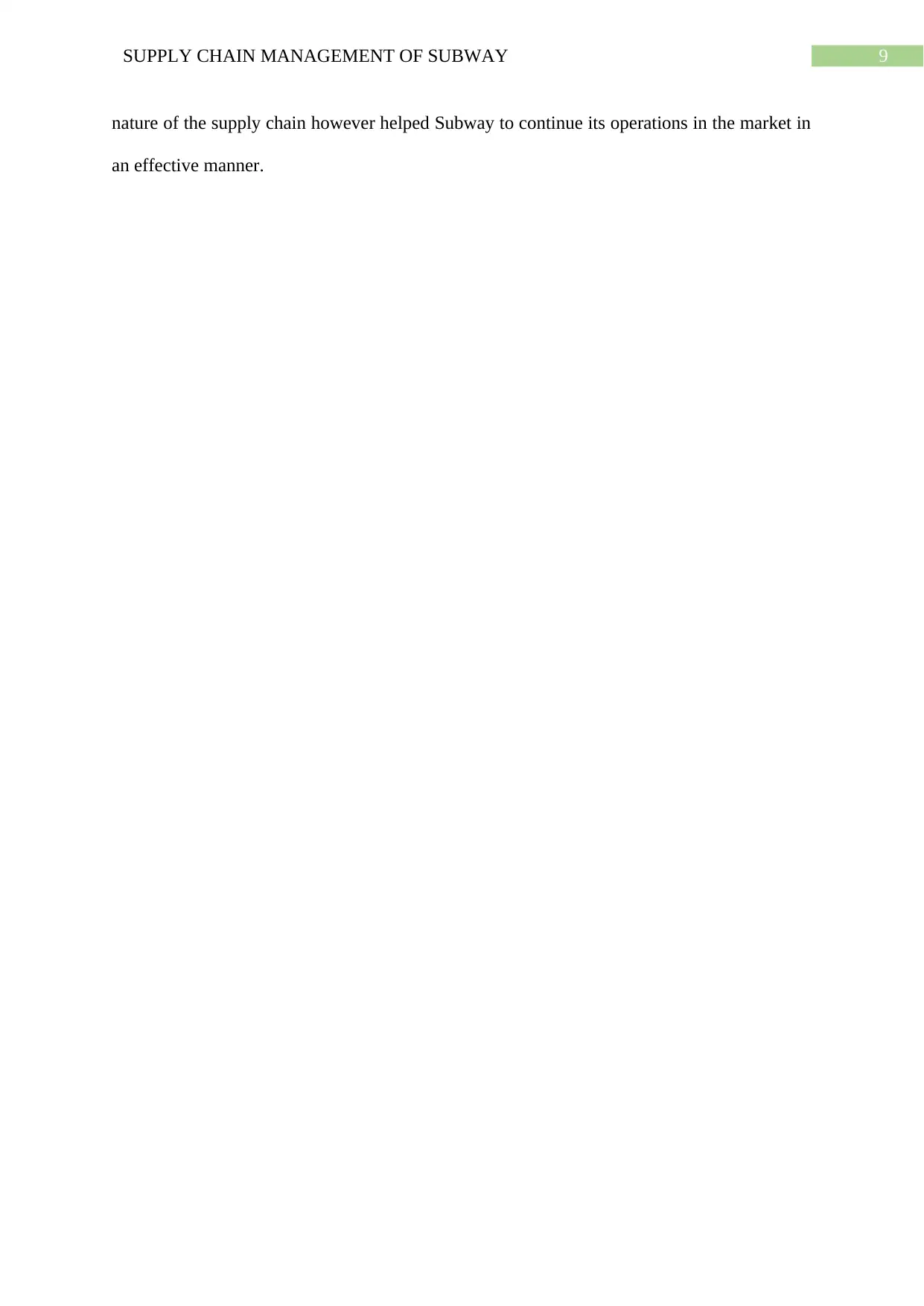
9SUPPLY CHAIN MANAGEMENT OF SUBWAY
nature of the supply chain however helped Subway to continue its operations in the market in
an effective manner.
nature of the supply chain however helped Subway to continue its operations in the market in
an effective manner.
Paraphrase This Document
Need a fresh take? Get an instant paraphrase of this document with our AI Paraphraser
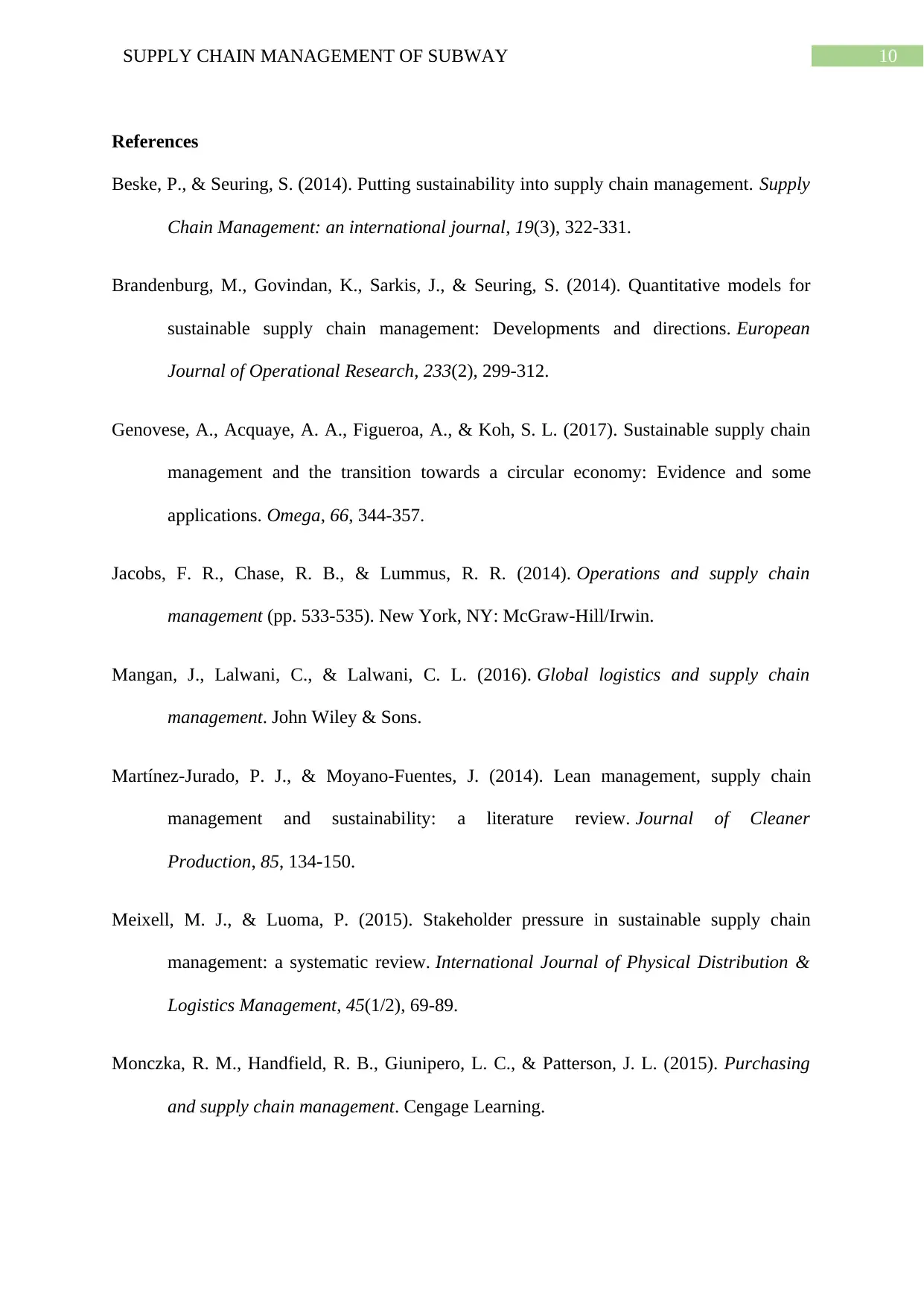
10SUPPLY CHAIN MANAGEMENT OF SUBWAY
References
Beske, P., & Seuring, S. (2014). Putting sustainability into supply chain management. Supply
Chain Management: an international journal, 19(3), 322-331.
Brandenburg, M., Govindan, K., Sarkis, J., & Seuring, S. (2014). Quantitative models for
sustainable supply chain management: Developments and directions. European
Journal of Operational Research, 233(2), 299-312.
Genovese, A., Acquaye, A. A., Figueroa, A., & Koh, S. L. (2017). Sustainable supply chain
management and the transition towards a circular economy: Evidence and some
applications. Omega, 66, 344-357.
Jacobs, F. R., Chase, R. B., & Lummus, R. R. (2014). Operations and supply chain
management (pp. 533-535). New York, NY: McGraw-Hill/Irwin.
Mangan, J., Lalwani, C., & Lalwani, C. L. (2016). Global logistics and supply chain
management. John Wiley & Sons.
Martínez-Jurado, P. J., & Moyano-Fuentes, J. (2014). Lean management, supply chain
management and sustainability: a literature review. Journal of Cleaner
Production, 85, 134-150.
Meixell, M. J., & Luoma, P. (2015). Stakeholder pressure in sustainable supply chain
management: a systematic review. International Journal of Physical Distribution &
Logistics Management, 45(1/2), 69-89.
Monczka, R. M., Handfield, R. B., Giunipero, L. C., & Patterson, J. L. (2015). Purchasing
and supply chain management. Cengage Learning.
References
Beske, P., & Seuring, S. (2014). Putting sustainability into supply chain management. Supply
Chain Management: an international journal, 19(3), 322-331.
Brandenburg, M., Govindan, K., Sarkis, J., & Seuring, S. (2014). Quantitative models for
sustainable supply chain management: Developments and directions. European
Journal of Operational Research, 233(2), 299-312.
Genovese, A., Acquaye, A. A., Figueroa, A., & Koh, S. L. (2017). Sustainable supply chain
management and the transition towards a circular economy: Evidence and some
applications. Omega, 66, 344-357.
Jacobs, F. R., Chase, R. B., & Lummus, R. R. (2014). Operations and supply chain
management (pp. 533-535). New York, NY: McGraw-Hill/Irwin.
Mangan, J., Lalwani, C., & Lalwani, C. L. (2016). Global logistics and supply chain
management. John Wiley & Sons.
Martínez-Jurado, P. J., & Moyano-Fuentes, J. (2014). Lean management, supply chain
management and sustainability: a literature review. Journal of Cleaner
Production, 85, 134-150.
Meixell, M. J., & Luoma, P. (2015). Stakeholder pressure in sustainable supply chain
management: a systematic review. International Journal of Physical Distribution &
Logistics Management, 45(1/2), 69-89.
Monczka, R. M., Handfield, R. B., Giunipero, L. C., & Patterson, J. L. (2015). Purchasing
and supply chain management. Cengage Learning.
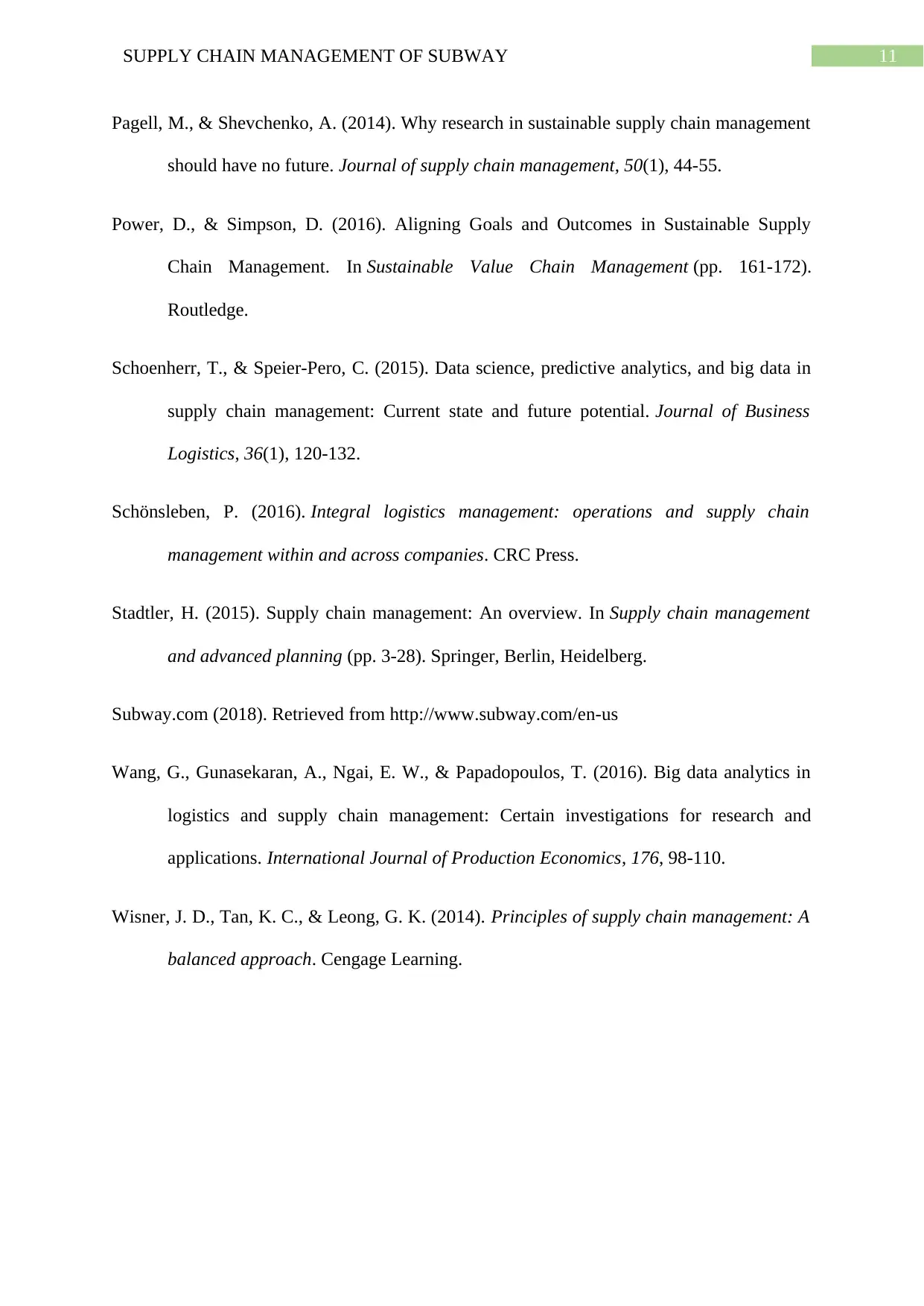
11SUPPLY CHAIN MANAGEMENT OF SUBWAY
Pagell, M., & Shevchenko, A. (2014). Why research in sustainable supply chain management
should have no future. Journal of supply chain management, 50(1), 44-55.
Power, D., & Simpson, D. (2016). Aligning Goals and Outcomes in Sustainable Supply
Chain Management. In Sustainable Value Chain Management (pp. 161-172).
Routledge.
Schoenherr, T., & Speier‐Pero, C. (2015). Data science, predictive analytics, and big data in
supply chain management: Current state and future potential. Journal of Business
Logistics, 36(1), 120-132.
Schönsleben, P. (2016). Integral logistics management: operations and supply chain
management within and across companies. CRC Press.
Stadtler, H. (2015). Supply chain management: An overview. In Supply chain management
and advanced planning (pp. 3-28). Springer, Berlin, Heidelberg.
Subway.com (2018). Retrieved from http://www.subway.com/en-us
Wang, G., Gunasekaran, A., Ngai, E. W., & Papadopoulos, T. (2016). Big data analytics in
logistics and supply chain management: Certain investigations for research and
applications. International Journal of Production Economics, 176, 98-110.
Wisner, J. D., Tan, K. C., & Leong, G. K. (2014). Principles of supply chain management: A
balanced approach. Cengage Learning.
Pagell, M., & Shevchenko, A. (2014). Why research in sustainable supply chain management
should have no future. Journal of supply chain management, 50(1), 44-55.
Power, D., & Simpson, D. (2016). Aligning Goals and Outcomes in Sustainable Supply
Chain Management. In Sustainable Value Chain Management (pp. 161-172).
Routledge.
Schoenherr, T., & Speier‐Pero, C. (2015). Data science, predictive analytics, and big data in
supply chain management: Current state and future potential. Journal of Business
Logistics, 36(1), 120-132.
Schönsleben, P. (2016). Integral logistics management: operations and supply chain
management within and across companies. CRC Press.
Stadtler, H. (2015). Supply chain management: An overview. In Supply chain management
and advanced planning (pp. 3-28). Springer, Berlin, Heidelberg.
Subway.com (2018). Retrieved from http://www.subway.com/en-us
Wang, G., Gunasekaran, A., Ngai, E. W., & Papadopoulos, T. (2016). Big data analytics in
logistics and supply chain management: Certain investigations for research and
applications. International Journal of Production Economics, 176, 98-110.
Wisner, J. D., Tan, K. C., & Leong, G. K. (2014). Principles of supply chain management: A
balanced approach. Cengage Learning.
⊘ This is a preview!⊘
Do you want full access?
Subscribe today to unlock all pages.

Trusted by 1+ million students worldwide
1 out of 12
Related Documents
Your All-in-One AI-Powered Toolkit for Academic Success.
+13062052269
info@desklib.com
Available 24*7 on WhatsApp / Email
![[object Object]](/_next/static/media/star-bottom.7253800d.svg)
Unlock your academic potential
Copyright © 2020–2025 A2Z Services. All Rights Reserved. Developed and managed by ZUCOL.





